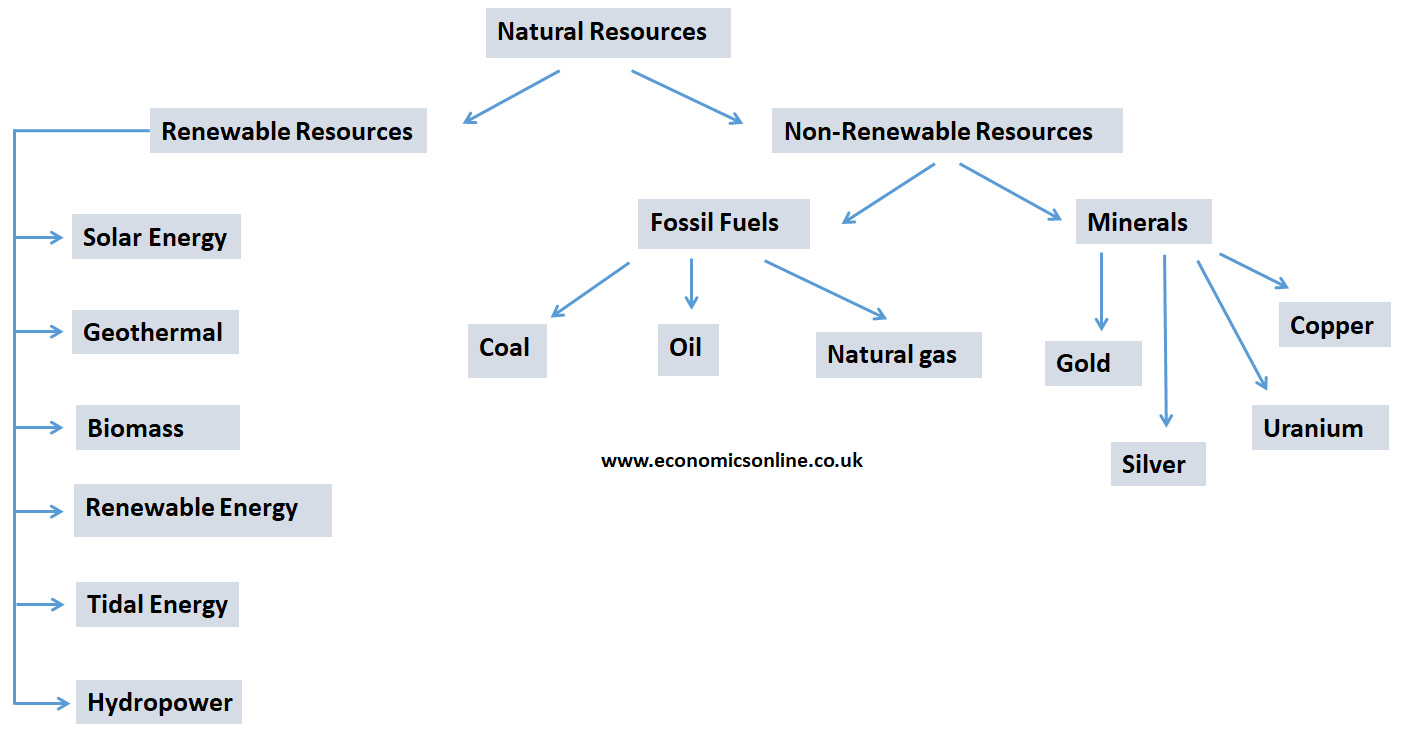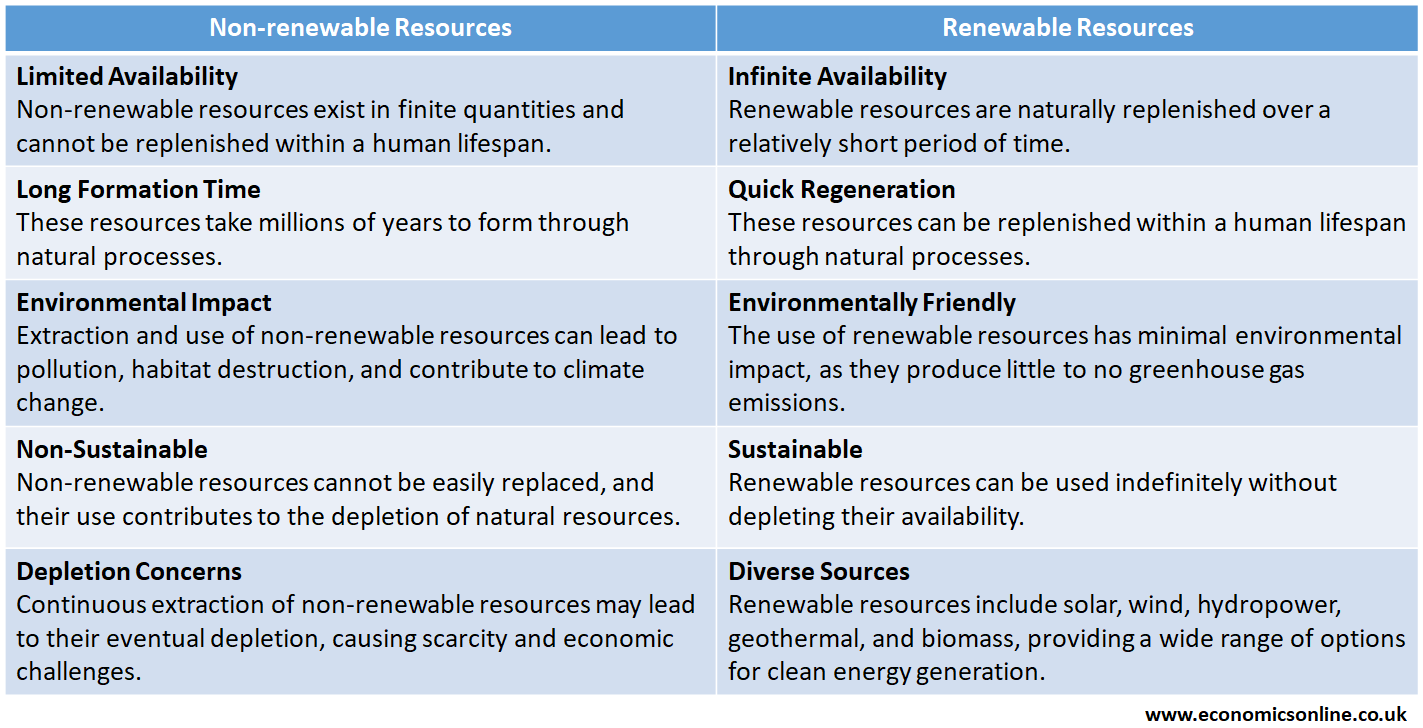
Photo by Joshua Newton / Unsplash
Non-Renewable Resources
Definition
Non-renewable resources refer to natural resources that cannot be regenerated once depleted.
These non-renewable resources can’t be easily formed or regenerated in a man’s lifetime because they regenerate at a much slower rate as compared to the rate of their depletion. In fact, non-renewable resources take centuries to form. These resources are finite in quantity and, once depleted, cannot be readily restored.
Examples
An example of a non-renewable resource is crude oil. Crude oil is used to make gasoline, diesel, and some other fuels as well. The formation of crude oil takes millions of years, but it diminishes rapidly.
Other examples of non-renewable resources include fossil fuels such as coal, oil, and natural gas, as well as minerals and metals like iron, copper, and aluminum.
Types of Non-renewable Resources
Nonrenewable resources are categorised into two main types: fossil fuels and minerals.

Fossil Fuels
The resources of energy formed from the remains of dead plants and animals that had been extinct millions of years ago are known as fossil fuels.
Fossil fuels are important because they are used for producing electricity, moving transportation vehicles, and providing heat through burning. Fossil fuels also create environmental issues such as global warming, ozone depletion, etc.
Fossil fuels are further divided into coal, oil, and natural gas.
Coal
Coal is a type of fossil fuel. It is formed from the dead remains of plants and animals buried in the rocks millions of years ago. Coal is made up of carbon dioxide and a combination of other oxides that are harmful for living beings.
Pros of Coal
The pros of using coal are:
- Abundant and widely available
- Relatively low cost compared to other energy sources
- Established infrastructure for coal mining and power plants
Cons of Coal
The cons of using coal are:
- High carbon emissions and contribution to climate change
- Air pollution and its negative impact on human health
- Environmental damage from mining and waste disposal
Oil
Oil is another type of fossil fuel. Oil is extracted from deep oceans or by digging into the earth’s crust. Oil is formed from the dead remains of extinct ancient plants and living bodies inside the ocean or marine ecosystem.
Pros of Oil
The pros of using oil are:
- High energy density, making it efficient for transportation
- Well-established infrastructure for extraction, refining, and distribution.
- Versatile and used in various industries
Cons of Oil
The cons of using oil are:
- Greenhouse gas emissions, when burned, contribute to climate change
- Environmental risks from oil spills during extraction, transportation, and storage
- Finite source with concerns about future availability
- Dependence on oil can lead to geographical and economic instability
Natural Gas
Natural gas is also a fossil fuel. Natural gas is present inside the earth’s surface. Natural gas is composed of methane. Natural gas is commonly used in households for cooking, heating, etc. It is not harmful like other kinds of fossil fuels.
Pros of Natural Gas
The pros of using natural gas are:
- Cleaner burning compared to coal and oil results in lower greenhouse gas emission
- Abundant and widely available in many regions
- Efficient energy source with high energy density
Cons of Natural Gas
The cons of using natural gas are:
- Methane emissions during extraction and transportation contribute to climate change
- Environmental concerns related to fracking, a method used to extract natural gas
- Dependence on natural gas can hinder the transition to renewable energy sources
Minerals
The natural inorganic substances present under the earth’s crust are known as minerals.
Examples of minerals include copper, gold, silver, iron ore, uranium, and rare earth elements
Minerals are essential for various industries, including construction, electronics, manufacturing, and energy production.
Other Non-renewable Energy Sources
There are some other sources of nonrenewable energy resources except fossil fuels, which are:
Nuclear Energy
Nuclear power is generated through the process of nuclear fission in nuclear power plants, where the nucleus of an atom is split, releasing a large amount of energy. While nuclear energy is not renewable, it is a low-carbon source of electricity.
Uranium and Thorium
These are the primary nuclear fuels used in nuclear reactors to produce nuclear energy. They are nonrenewable energy sources that are mined from the earth.
Geothermal Energy
Geothermal energy harnesses heat from within the earth to generate electricity. While it is considered a renewable energy source, the heat within the planet earth is not infinite, making it a non-renewable resource over very long periods of time.
Tar Sands and Oil Shale
These are unconventional sources of oil that require more intensive extraction processes compared to conventional oil. They are considered non-renewable due to their finite nature.
Non-renewable Resources vs. Renewable Resources
The following table explains the main points of difference between nonrenewable resources and renewable resources.

Non-renewable Resources and Climate Change
Non-renewable resources such as fossil fuels, coal, natural gas, petroleum products, etc., are burned, causing air and water pollution and affecting marine habitat. It is also responsible for causing respiratory infections in humans and other living organisms. When we burn these resources for energy sources, it emits harmful gases in high amounts, like CO2, SO2, and NO2, etc. These gases are responsible for greenhouse effects that trap heat from the sun towards the earth and don't allow this heat to exit the earth’s atmosphere, causing an increase in temperature. This increase in temperature leads to a change in the climate of the ecosystems of different living organisms. Climate change, such as high temperatures orutilisation extreme changes in weather conditions, also occurs. Hence, we should shift our needs from non-renewable resources to renewable resources and prevent resources for our future generations.
The Growth of Renewable Resources
Renewable resources are important for their significant usefulness around the globe. Renewable sources of energy like solar, wind, and hydropower are used for different purposes, like generating electricity through solar panels. People also produce electricity through wind power. These resources are used as alternatives for different purposes. Governments, individuals, and businesses are investing in renewable resources like solar energy to reduce the use of non-renewable resources.
Advantages of Non-renewable Energy
Non-renewable resources have the following advantages:
High Energy Density
Non-renewable resources like fossil fuels have a high energy content, making them efficient for energy production.
Established Infrastructure
The infrastructure for extracting, refining, and distributing non-renewable resources is well developed, providing reliable source of energy.
Cost Effective
Non-renewable resources are often more affordable in the short term due to their abundance and established supply chains.
On-demand Availability
Non-renewable resources can be accessed and used whenever needed, providing a consistent energy supply.
Technological Advancements
The extraction and utilisation of non-renewable resources have driven technological innovations and economic growth.
Disadvantages of Non-renewable Energy
The following are the disadvantages of non-renewable resources:
Geopolitical Conflicts
Dependence on non-renewable resources can lead to geopolitical tensions and conflicts over access to and control of these resources.
Health Risks
The extraction and use of non-renewable resources can have adverse health effects on workers and nearby communities due to exposure to pollutants and hazardous substances.
Unsustainable
Reliance on non-renewable resources is not sustainable in the long term, as it depletes finite resources and contributes to environmental degradation.
Environmental Impact of Non-Renewable Energy
The following are some points that explain the impact of non-renewable energy resources:
Greenhouse Gases
Greenhouse gases like CO2 are emitted from refrigerators and air conditioning, causing the degradation of the ozone layer. Non-renewable resources like fossil fuels, coal, etc., when burned, release harmful gases that increase the temperature of the atmosphere, causing global warming, etc.
Air Pollution
The burning of non-renewable resources emits harmful pollutants that pollute the air, causing suffocation, respiratory infections, and especially smog in the winter, which causes eye infections. SO2, NO2, etc., are emitted from burning these resources.
Water Pollution
Water pollution is caused when pollutants directly dump into the water resources.
For example, oil spills directly dump into the ocean, and coal remains, causing harmful effects on marine ecosystems. It also affects the quality of drinking water.
Land Degradation
When people mine on rocks to extract natural resources, this may cause land degradation. When people need land for mining, they cut down trees to dig into the land, causing deforestation and ruining the habitat of living organisms.
Conservation of Non-renewable Energy
The following are the reasons why the conservation of non-renewable energy is important:
Finite Resources
Finite resources refer to non-renewable resources that are limited in quantity, such as fossil fuels, crude oil, etc. The finite resources have limited availability for use. We must conserve these non-renewable resources for our future generations.
Environmental Impact
The extraction of these resources has a negative impact on the environment, causing water, air, and land pollution and having worse effects on the ecosystems of plants and animals.
Climate Change
Non-renewable resources are responsible for the changing climate for humans and other living organisms, causing greenhouse gas emissions, etc.
Conclusion
In conclusion, non-renewable resources are those that can’t be reproduced. So, we have to prevent these resources from being wasted because they take thousands of years to form. We should adopt practices that use less of these resources and preserve them for our future generations.


